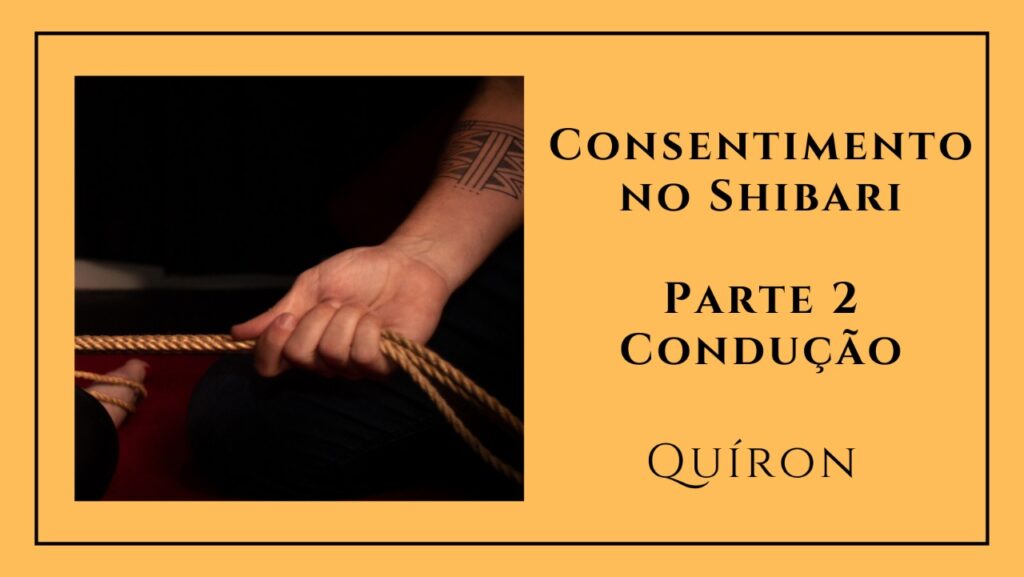📖 SHIBARI Categoria: Prática BDSM / Bondage Artístico Japonês
🔑 PALAVRAS-RELACIONADAS Kinbaku, bondage japonês, cordas eróticas, suspensão, amarração artística, dominação estética, restrição sensorial.
🔠 DEFINIÇÃO Shibari é uma prática de bondage de origem japonesa que utiliza cordas para criar amarrações complexas, com foco estético, emocional e erótico. Diferente do bondage ocidental, o Shibari prioriza a beleza visual da amarração e a conexão entre quem amarra (rigger) e quem é amarrado (modelo ou submisso).
🔎 SIGNIFICADO Mais do que prender o corpo, o Shibari envolve um diálogo sensorial e psicológico entre dominador e submisso. As cordas se tornam uma extensão da vontade do rigger, moldando posturas, restringindo movimentos e criando estados de vulnerabilidade que intensificam a entrega. A fricção da corda na pele, a pressão em pontos estratégicos e a sensação de contenção total produzem um tipo único de prazer: silencioso, intenso e meditativo.
🔗 APLICAÇÃO O Shibari pode ser aplicado de forma estática (com o submisso em posições fixas no chão ou contra superfícies) ou em suspensões (com o corpo parcialmente ou totalmente elevado pelas cordas). Exemplos de uso: ✔ Amarrações de peito, pernas e braços com cordas de juta ou cânhamo; ✔ Posturas que evocam submissão, oferenda ou exposição erótica; ✔ Suspensões completas em estruturas de madeira ou aço; ✔ Combinação com meditação, spanking, wax play ou privação sensorial; ✔ Sessões performáticas com apelo artístico e emocional.
🧠 IMPACTO MENTAL, FÍSICO E EMOCIONAL Mentalmente, o Shibari induz um estado de introspecção e subspace. Fisicamente, ativa pontos de pressão e libera endorfinas por meio da contenção. Emocionalmente, gera confiança, entrega e uma sensação de ser “possuído” pelas cordas. Para muitos, é uma forma de meditação erótica e submissão plena.
📢 RELAÇÃO COM OUTROS TERMOS ✔ Kinbaku – Termo mais tradicional, usado no Japão, que significa “ligar com força”; ✔ Bondage – Prática geral de amarração no BDSM; ✔ Rigger – Pessoa que amarra no Shibari; ✔ Rope Bunny – Submisso que se oferece para ser amarrado; ✔ Dominação estética – Quando o foco é visual e emocional tanto quanto físico.
🔒 NEGOCIAÇÃO ✔ Verificar experiência e técnica do rigger; ✔ Discutir posições, tempo de amarração, tipo de corda e zonas sensíveis; ✔ Definir limites claros para contenção, dor e exposição; ✔ Ter sinal de segurança claro e visível mesmo sem fala (movimentos ou objetos).
💊 CUIDADOS ANTES E DEPOIS ✔ Fazer aquecimento corporal leve antes da amarração; ✔ Avaliar circulação, articulações e histórico de lesões; ✔ Após a sessão, remover as cordas com calma, fazer massagem de reativação e oferecer aftercare emocional intenso.
🚀 IMPACTO FINAL Ser amarrado com Shibari é transformar o corpo em arte, e a submissão em entrega absoluta e silenciosa.
🔍 6 PERGUNTAS MAIS PESQUISADAS SOBRE SHIBARI
- Qual a diferença entre Shibari e bondage comum? Shibari é uma forma de bondage japonesa com foco na estética e na conexão emocional, enquanto o bondage ocidental é mais funcional e menos ritualizado.
- Shibari dói? Pode causar desconforto intencional e prazeroso, mas nunca dor perigosa. A sensação depende da pressão, do tempo e da sensibilidade do submisso.
- Preciso ser flexível para praticar Shibari? Não necessariamente. O rigger deve adaptar a amarração ao corpo do submisso, respeitando limitações físicas.
- Quais cordas são usadas no Shibari? Cordas de juta ou cânhamo são as mais tradicionais, pois têm textura, firmeza e cheiro específicos que contribuem para a experiência sensorial.
- É possível praticar Shibari com segurança em casa? Sim, desde que com estudo prévio, atenção à anatomia e práticas seguras. É ideal começar com amarrações básicas antes de tentar suspensões.
- Shibari é sempre sexual? Não. Pode ser erótico, sensual, meditativo ou puramente artístico. A carga sexual depende da intenção dos envolvidos.

📖 SHIBARI
Category: BDSM Practice / Japanese Artistic Bondage
🔑 RELATED WORDS
Kinbaku, Japanese bondage, erotic ropes, suspension, artistic tying, aesthetic domination, sensory restriction.
🔠 DEFINITION
Shibari is a Japanese bondage practice that uses ropes to create complex ties with aesthetic, emotional, and erotic focus. Unlike Western bondage, Shibari emphasizes the visual beauty of the tying and the connection between the rigger (the one who ties) and the model or submissive.
🔎 MEANING
More than restraining the body, Shibari is a sensory and psychological dialogue between Dominant and submissive. The ropes become an extension of the rigger’s will, shaping posture, restricting movement, and creating vulnerability that deepens submission. The friction of the rope on skin, the pressure on specific points, and the sensation of full containment generate a unique kind of pleasure: silent, intense, and meditative.
🔗 APPLICATION
Shibari can be practiced in static form (with the submissive tied on the ground or to surfaces) or in suspensions (with the body partially or completely lifted by the ropes). Common uses include: ✔ Chest, leg, and arm ties with jute or hemp ropes; ✔ Poses evoking submission, offering, or erotic display; ✔ Full suspensions on wood or steel frames; ✔ Integration with meditation, spanking, wax play, or sensory deprivation; ✔ Performative sessions with artistic and emotional appeal.
🧠 MENTAL, PHYSICAL, AND EMOTIONAL IMPACT
Mentally, Shibari induces introspection and subspace. Physically, it stimulates pressure points and releases endorphins through restraint. Emotionally, it builds trust, surrender, and the sense of being “possessed” by the ropes. For many, it is a form of erotic meditation and deep submission.
📢 RELATIONSHIP WITH OTHER TERMS
✔ Kinbaku – A more traditional Japanese term meaning “tight binding”;
✔ Bondage – The broader practice of physical restraint in BDSM;
✔ Rigger – The person tying in a Shibari scene;
✔ Rope Bunny – The submissive who enjoys being tied;
✔ Aesthetic domination – Where the visual and emotional experience is as important as the physical one.
🔒 NEGOTIATION
✔ Confirm the rigger’s experience and safety knowledge; ✔ Discuss positions, duration, rope types, and sensitive areas; ✔ Set clear limits for restraint, pain, and exposure; ✔ Establish non-verbal safety signals (in case the submissive enters subspace).
💊 CARE BEFORE AND AFTER
✔ Light warm-up before tying to prepare the body; ✔ Check circulation, joints, and injury history; ✔ Aftercare includes slow rope removal, gentle massage, and emotional reassurance.
🚀 FINAL IMPACT
Being tied in Shibari turns the body into art and submission into silent, absolute surrender.
🔍 6 MOST SEARCHED QUESTIONS ABOUT SHIBARI
- What is the difference between Shibari and regular bondage?
Shibari is a Japanese style of bondage with aesthetic and emotional focus, while Western bondage is often more functional and less ritualistic. - Does Shibari hurt?
It can cause intentional, pleasurable discomfort but should never lead to harmful pain. The sensation depends on pressure, time, and the submissive’s sensitivity. - Do I need to be flexible to practice Shibari?
Not necessarily. The rigger should adapt the tie to the submissive’s body and respect physical limits. - What kind of ropes are used in Shibari?
Jute and hemp ropes are traditional, offering texture, firmness, and scent that enhance the sensory experience. - Can Shibari be practiced safely at home?
Yes, with proper study, anatomical awareness, and safety practices. Beginners should start with floor ties before attempting suspension. - Is Shibari always sexual?
No. It can be erotic, sensual, meditative, or purely artistic. The sexual charge depends on the intent of those involved.

UMA INTRODUÇÃO SOBRE A HISTÓRIA DO SHIBARI
CONSENTIMENTO NO SHIBARI – PARTE 1 – NEGOCIAÇÃO
CONSENTIMENTO NO SHIBARI – PARTE 2 – CONDUÇÃO
UM ENSAIO DE SHIBARI CHEIO DE PELE, MUITO SILÊNCIO E UM MÍNIMO DE CORDAS











